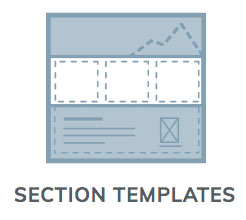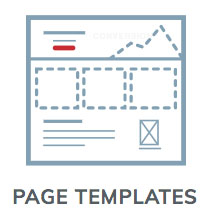How to use Page + Section Templates
Whether or not you realized it, the pages you build all have goals. These goals may or or may not be commercial, but all pages communicate information and are intended to be read or used in some way.
Pages can be organized in a way that makes it easier for readers to understand and use that information. And the best approach is not always obvious, especially starting out with a blank page.
So we’ve included pre-built page and section templates to give you a strong start.
This quick start guide tells you where to access them and how to use them to make your own landing pages.
Section Templates

All columns and design elements will scale down automatically and look good on devices that are too small to show a full page. In fact, all section templates are responsive and come from either the C9 Grid or the C9 Posts Grid.
Every section template uses a combination of core WordPress blocks (photos, image galleries, paragraphs, headings, YouTube video embeds, etc.) and sometimes include C9 Blocks. (C9 Headings, C9 Toggles, C9 Tabs, C9 Carousels, C9 Image Carousels, etc.)
When might section templates come in handy?
Longer pages
For example, you might want to have a somewhat longer page with a lot of different content blocks to help someone decide to sign up for your service, app, or to buy your product. That means you’ll need some sort of page header, a body content container, and some sort of call-to-action such as a social share, or call to action block, lead form, or a button to go buy a ticket or buy a product in your shop.
Something brief
In contrast, you may at times just need a quick ‘elevator pitch’ for your landing page. It could have a short message in your page header, a brief features list, and a signup form for people that are ready take the next step.
Quickly previewing for mobile devices
Skip the blank screen and blinking cursor if all you want to do is get a feel for how responsive page sections will look on a mobile device. Start from saved block section templates instead. It only takes a couple clicks!
Once you’ve gotten used to managing content in a few of our section templates, you can begin to either build your own Reusable Block Layouts from scratch, or even entire page templates.
Page Templates

C9 Blocks comes with an eclectic set of complete landing page templates to suit a variety of objectives. Site visitors arrive from all types of places (search engines, other websites, direct..) and for a variety of reasons. Every page, then, is a gateway into your site so you should provide purpose, flow, and somewhere for your visitor to go or something for them to do.
Landing page templates are organized by your visitors’ purposes, also called the “content (or customer) journey” — modeled after a basic sales funnel.
The Content Journey
- Awareness
- Consideration
- Conversion
Wait, what’s the content journey?
“Content journey” is marketing-speak for, a series of steps in a decisionmaking process — often for some type of purchase. You may also know it as the “buyer’s journey” or “fan’s journey” or “customer’s journey.”
Every visitor you get has some level of understanding of your brand/company/charity/organization. Their understanding ranges from being completely unaware of your existence all the way up to being your most loyal customers and superfans. (Hi Mom + Dad!!!)
First time visitors or those who don’t know you well yet are said to be in the Awareness stage. These people know next to nothing about you so they’ll need a little more than just a logo, address, phone number, and paragraph of text before they’re willing to hand over their credit card information.
More general information is quite useful in the early stages. At this point the visitor has a basic motivation for stopping by and needs a better understanding of their situation or inspiration. Supporting their understanding makes you an authority. Repeated positive experiences on your site puts you into a position of “trusted authority.”
Take, for instance, a carefully created product page on an E-commerce site. All that helpful and useful information is designed to make it easier to buy the adult-sized Star Wars pajamas for the movie premiere. Every reservation in your mind about buying those 6 foot tall adult print pajamas is washed away by comparison pricing charts, frequently asked questions, and unexpectedly glowing customer testimonials splashed with headlines like, “EXTRA COMFY A++++++ PJs,” and “I WEAR THESE EVERY DAY IN MY ADULT TREE HOUSE/SPACESHIP.”
Coincidentally, you now also want to buy those sweet Yoda PJs!
What if you were already in the fan club and a long-time subscriber to the Star Wars pajamas email list? Well, then you probably didn’t need 4,000 words of details and reassurance on the product landing page ’cause you already know the brand, the myth, the lingo, and the prequel memes. You were ready to buy the day they went on sale for preorder so all you need is a link, a picture, and a button to purchase.
And for that reason, it may make sense to spread your product pages across more than one landing page. In fact, it’s useful to do so in most cases. One exception are landing pages for Pay per Click campaigns (Visitors from ads are typically beyond the Awareness stage).
The Star Wars Pajamas Content Journey
- Awareness:
- Customer: You’re going to the movie premiere and want to dress up. What do you wear?
- You: Publish this article – “How to achieve that ‘comfy-casual’ look when attending movie premieres”
- Consideration:
- Customer: “Ahh there are Star Wars PJs! But which one and where can I get it from?”
- You: “Here are all the latest artisan PJs made exclusively for Store B. Don’t miss the reviews!”
- Conversion:
- Customer: “This pair of PJs has all the features I want, even the butt flap! The price is right and the store is legit. Let’s do this!”
- You: “Here’s some after-purchase information and the button that levels up your movie premiere attire.
Organizing landing page templates by content journey stage is an easy way to multiply the number of [useful/helpful] pages on your site. By default, every topic or product has three pages that can be created to support it–each of which serves a sales (or conversion) purpose including findability in search engines.
This necessitates quite a lot of content to convince your visitor to do whatever it is you want them to do. Consideration landing pages are for people who are considering you. Either because they’ve heard of you from somewhere else, or you told them to go there and review your site to consider you, and finally, Conversion pages are built for a user to pull the trigger at the end. These may have very little content, or a few sections to get the minimum details and information before a user makes a decision.
Not every customer’s journey is so simple though, and we’ve had as many as 9 or 10 different steps in some of our sales funnels, but this should be a good starting point as you develop your own landing page templates.